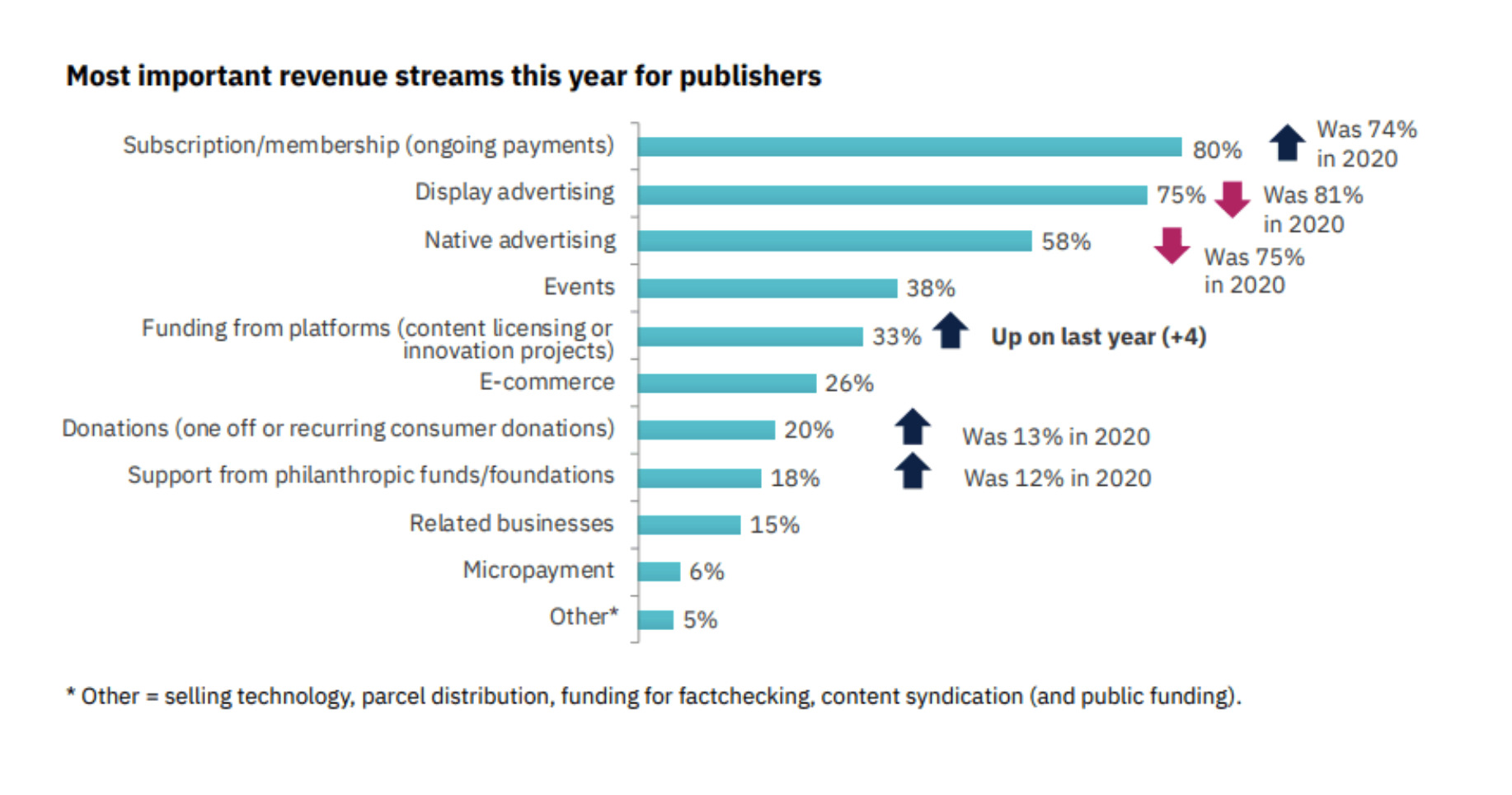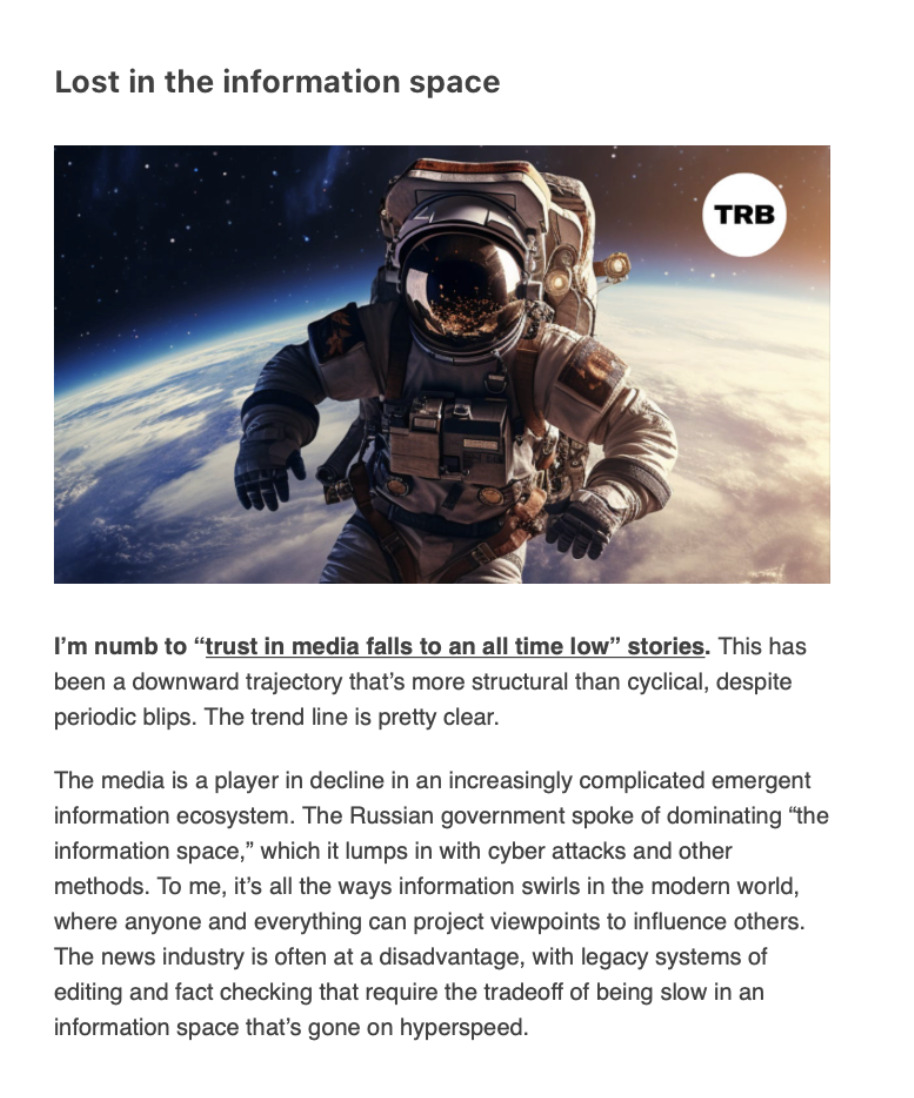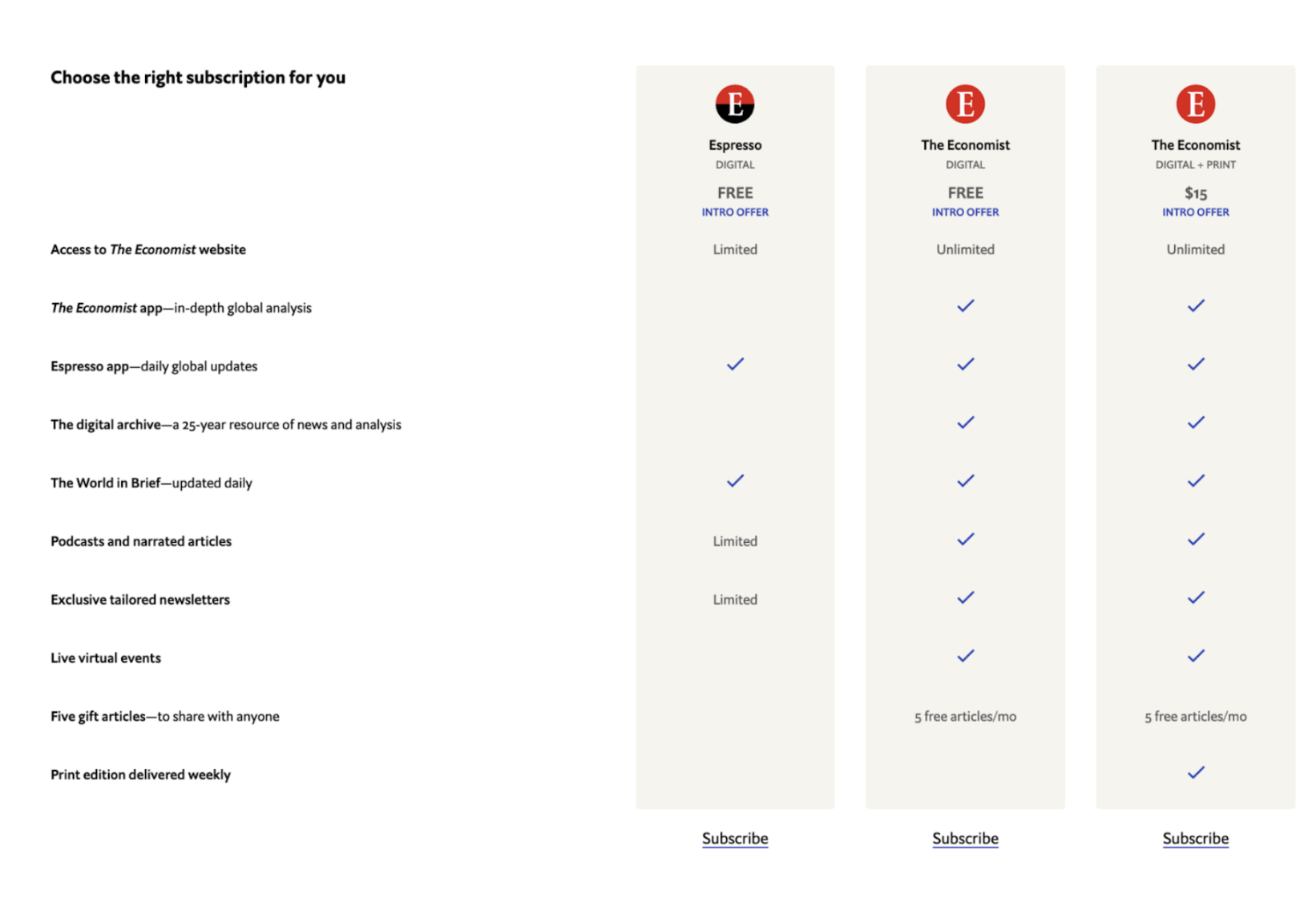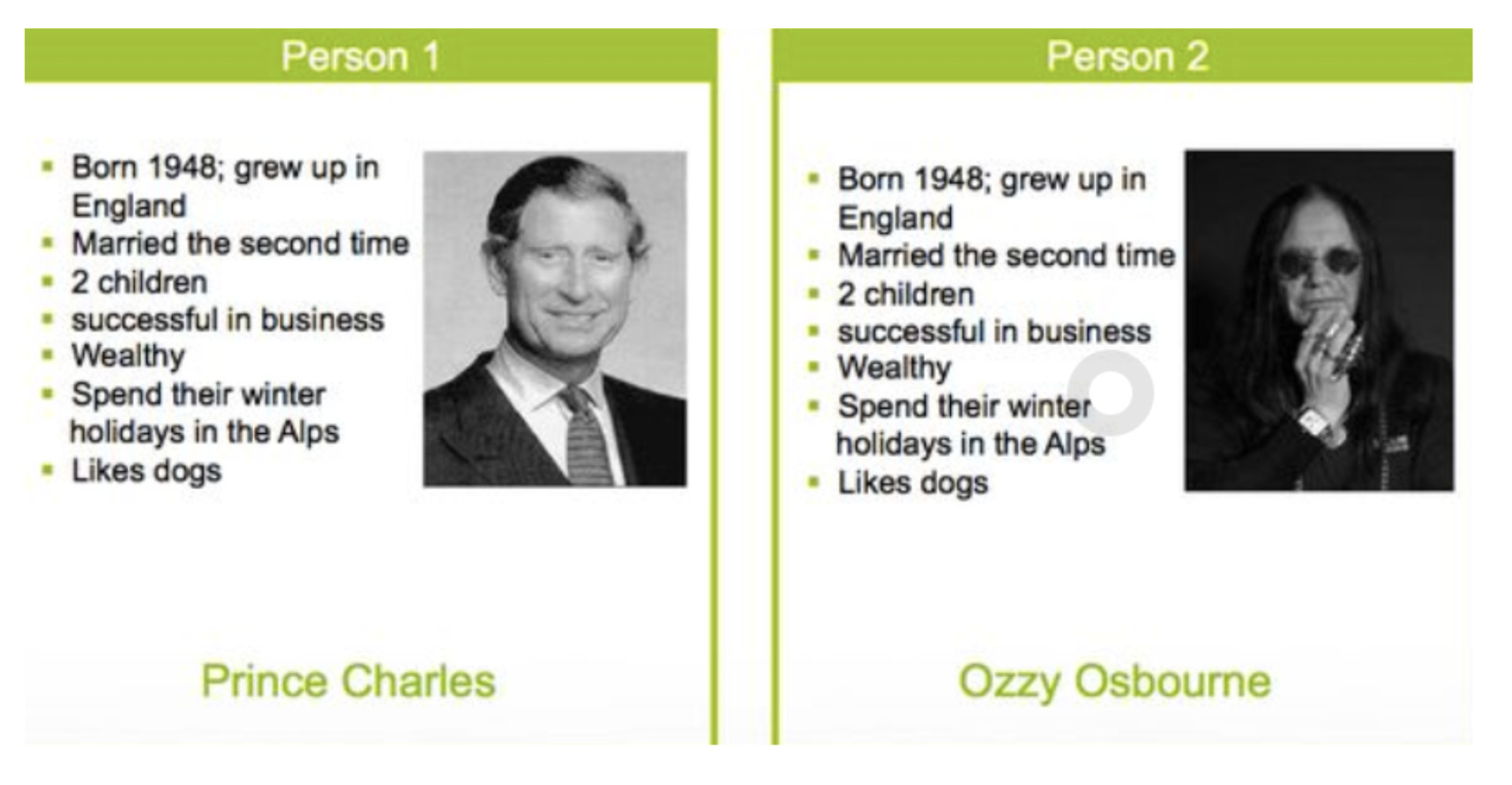The top 5 reasons why your audience subscribes
Last updated: May 13, 2024

According to The Reuters Institute for the Study of Journalism’s 2023 Digital News Report, more American consumers are paying for new subscriptions than ever. 21% of consumers were subscribed to at least one digital publication in 2023, up from 19% the year before.
While there’s still a way to go, this indicates that people are becoming more willing to pay for digital content.
Streamline your tech stack: Boost efficiency, unify data & retain talent! Get expert tips now:

What’s driving this shift?
- Paying for streaming services for several years may be making consumers more amenable to paying for digital website content as well.
- The onset of the 2024 US election cycle could be increasing interest in both national and local political coverage.
- Media organizations are making their paywalls more effective and using personalization to create more targeted, enticing offers.
- They’ve also begun using newsletters as a gateway to paid subscriptions. (Learn how to drive subscriptions from your newsletter readers here!)
Whatever the reason, this has big implications for media businesses. Subscription revenue has always been important, but it’s become an even bigger priority for publishers as ad revenue slows down and organic social traffic plummets. 80% of publishers said that subscriptions will be one of their most important revenue streams, up from 74% in 2020.
But if you’re struggling to get your audience to see the value of a paid subscription, this can feel very far away.
The first step to getting subscriptions: understanding why your audience subscribes and inspiring them to act. So in this post, we’re telling you why people subscribe — and how to win their business.
A distinctive voice and personality
It’s not just what you say. It’s how you say it.
And that’s especially important in a media landscape that’s getting more and more saturated. Today, you’re not just competing against other media brands anymore. You’re up against solo podcasters, Substack writers, influencers and seemingly your entire social feed. In an age when everyone has a microphone, how can you stand out?
Your personality.
Think about the newsletters and articles you read every week. Chances are, the writer’s not just throwing some Chat-GPT sounding paragraphs at you. Instead, they’re supporting their points with their personal stories and expertise, and splashing in some humor as needed.
That personal affinity drives people to subscribe, particularly in America: Around of American consumers say they pay for news (47%) because they identify with certain journalists or the stances of particular brands.
One of our favorite examples comes from The Rebooting newsletter, the media business newsletter written by Brian Morrissey, the former Editor in Chief of Digiday. In the newsletter, he pair his tried-and-true (Disclaimer: Omeda periodically sponsors The Rebooting.)

Morrissey has a distinct voice, irreverent sense of humor and a healthy skepticism of some commonly repeated best practices in the media. Whether you share his takes on the industry, you’ll remember it — and probably learn something, too.
Not everyone’s brand guidelines allow for snark or sassy pop culture references. But humanizing your content even a little stands out to readers and encourages them to connect with you. So if your numbers are flat, don’t be afraid to experiment within the confines of your brand guidelines.
3. Multi-format offerings
Sure, your main KPI is maximizing new subscriptions. But if you want to sustain your business long term, your real goal is getting your readers to form a habit of engaging with you. And they’re more likely to form that habit when it’s convenient for them to engage.
To facilitate this, diversify your content formats to include audio, video and email. According to research from Reuters, publishers say that they will be putting more resources into podcasts and digital audio (72%) as well as email newsletters (69%), both of which have been proven effective in increasing loyalty to news brands.
If podcasts and videos are out of your budget, no worries. Look for ways to repurpose your newsletters and articles into shorter interactive content on social media.
Some places to start:
- Turn research into an infographic.
- Post a slideshare summarizing different data points.
- Use expert quotes as standalone graphics on social.
- Partner with other publications or creators to split the cost of producing podcasts, videos or other premium content (and as a bonus, you can cross-promote to both lists).
4. Experiential and educational add-ons
Anyone can put a prompt into ChatGPT and spit out some info. But not everyone can help their audience use it to better themselves, share that experience with others, and experience the best of its brand in real event settings. That’s the key to emotionally connecting with your audience and differentiating yourself over time.
For example, The Economist offers three different subscription tiers that provide more and more amenities as the price increases.
The least expensive option, Espresso, offers access to a mobile app and other content for $7.90. But the more expensive tiers go beyond “more articles” to provide personalized content and access to a broader community.

The digital-only and digital + print subscriptions allow members to share gift articles, attend live and virtual events and access more than 25 years of resources. These subscribers aren’t just reading more Economist content – they’re able to network with like-minded people and share their knowledge with their friends and colleagues as well.
Don’t have the Economist’s event budget? No problem. Consider creating a community group on Slack or an internal platform, hosting subscriber-exclusive educational webinars, offering consultation sessions or free gift articles.
Design your subscription package around education and community to maximize subscriptions and retention.
5. Psychographic targeting
Segmentation makes your messaging more relevant on a group level. But even within one segment, everybody’s different, as demonstrated by Ozzy Osbourne and Prince Charles.

One VP of Audience Development might be drawn to your exclusive industry research, whereas another might be pulled in by your promotional offer. Account for these psychological differences when creating your promotional strategy.
Sounds good in theory, but how can you put this in practice?
The American Press Institute split news subscribers into three different personas, each with their own reasons for reading and subscribing. This includes:
Civically Committed support missions and initiatives that reflect their personal values and commit to a higher-than-average number of subscriptions.
How to engage them: This group is the most intrinsically motivated to subscribe. But it’s not a given. Mission-focused messaging is most likely to make them commit. Incorporate these appeals on your meter messages, landing pages and home pages to emphasize your unique value and inspire action.
One of our favorite examples comes from Mother Jones, which uses paid subscriptions to remain independent and directly fund its coverage of underreported stories. Its landing page drives this home perfectly, simply stating, ”Support nonprofit journalism.” The subhead reinforces that point by telling prospective subscribers that their funding will help Mother Jones create stories nobody else will produce. This focused, mission-driven value prop will convince interested parties to act – and pay.
Thrifty Transactors pay for practical value, but are highly selective about which publications make the cut.
How to engage them: This group is the most budget-conscious of the three. But they see the value of your publication — and making the right offer at the right time can convince them to buy.
Research backs this up: Around half of non-subscribers say that nothing could persuade them to pay for online news, but others could be attracted by a lower price, more relevant content, or less cluttered (ad-free) websites and apps, per research from the Reuters Institute and the University of Oxford.
And once they’re in the habit of reading, you can use personalization, dynamic content and recommendations to reinforce your value and keep them engaged for the long haul. You just need to get them in the door first.
So how do you do this? Consider using tiered pricing or promotional offers strategically. If you have multiple publications, allow them to create their own subscription bundle. If they can choose what kind of content they receive, they’re more likely to see your value and subscribe.
Elusive Engagers are generally subscription-averse and view news and information as a commodity that’s easily obtained for free.
How to engage them: Like Thrifty Transactors, Elusive Engagers are also cost-conscious. But their reluctance stems from undervaluing digital content rather than the list price, so you’ll need a different strategy here.
This audience is more likely to find experiential and educational offerings more valuable than content. Consider adding perks like exclusive resources and templates, consultations, videos, access to an online community, or event access to spark their interest and increase subscriptions.
Subscribe to our newsletter
Sign up to get our latest articles sent directly to your inbox.
What you should do now
- Schedule a Demo to see how Omeda can help your team.
- Read more Marketing Technology articles in our blog.
- If you know someone who’d enjoy this article, share it with them via Facebook, Twitter, LinkedIn, or email.